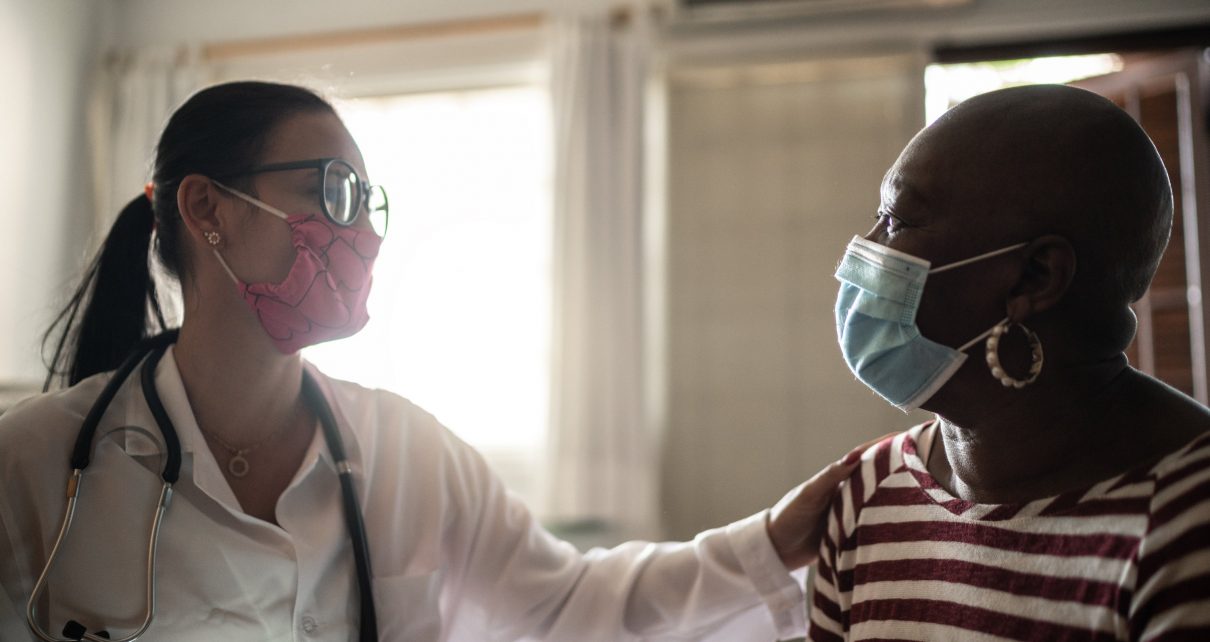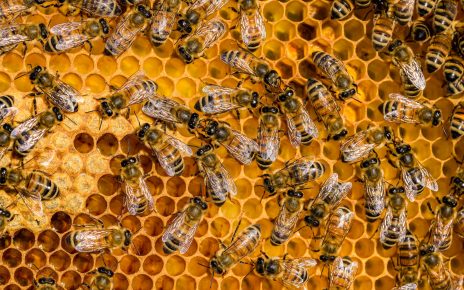George Floyd could not breathe. Like other Americans now numbering in the hundreds of thousands, he gasped horribly for air before his world went dark. Unlike them, his agony was not born from a lung-ravaging virus. He was strangled. He was killed in public, with the weight of anti-Black hatred kneeling terribly—almost boastfully—down on his neck.
Weeks before, and miles away, a comparison of public parks in New York shows the tale of two cities. In some, uniformed officers protect groups of friends basking in the sunlight by handing out masks and water. Elsewhere, they patrol. With eyebrows narrowed, they brutally arrest grieving folks of color for disobedience. Near Sacramento, a 14-year-old child is pinned to asphalt and beaten in the face. In Manhattan, a Black man is ground into asphalt for violating the six-feet social distancing order. An officer slaps him, kneels terribly down on his neck.
In the Emergency Department, a patient’s father halts me with a fanned palm a foot from my chest—prevents me from examining his child even though I’ve introduced myself as the doctor—and inquires if I’ve “been home recently.” My ability to take care of a gasping boy is questioned on account of my Taiwanese ethnicity. A week later, a triage nurse asks a new patient why he has come to the hospital. He responds, simply, that he had recently been “coughed on by [an] Asian.”
In this pandemic, data are taking a back seat to racial prejudice. The irrational racist surveillance that leads to the brutalization of Black Americans in their neighborhoods is spilling into public health and medical care. Fueled by a president who continues to blame a faceless China for the pandemic’s miseries, citizens and caregivers of color face fear and disdain. Simultaneously, re-emerging myths of genetic racial differences scrutinize bodies of color as sources of disease, all while obscuring the deadly climate of injustice that hastens breathlessness. America’s racism is rampant, and it’s shaping the response to this pandemic to the detriment of us all.
Travel bans missed the mark. Travelers from Europe—not Asia—brought the first cases of COVID-19 to at least 93 countries across five continents. Voyages from Italy were responsible for bringing COVID-19 to 46 nations, while travel from China is responsible for just 27 index cases. Yet, while the United States issued a travel ban on China at the end of January, it took another month and a half to limit European travel. During that time, an estimated two million people flew from Europe to the land of the free.
As with the greater globe, a majority of U.S. index cases came coughing, from Europe. But stigma has not followed these lines of export the way it sticks to Asia and other “aliens.” Conservative legislators call for deportations and stronger defenses at the Southern border, while the “normal reaction” of anti-Asian hatred skyrockets. Public political displays urging citizens to eat at empty Chinatown restaurants do little to stem the Sinophobia, but no such exhibition has been necessary to demonstrate the safety of spaghetti and meatballs.
The widespread media narrative is similarly skewed. German Chancellor Angela Merkel’s pedigree as a scientist with an advanced degree in quantum chemistry was celebrated as an explanation for the prowess of her pandemic response. But the reported success of Germany—a country of 83 million people, $3.9 trillion GDP, and over 9,300 COVID-19 deaths—does not seem so successful when compared to Vietnam, a country of 96 million people and $245 billion GDP, with zero COVID-19 deaths even in May. Though East Asia had fewer deaths in total than Europe had every day throughout the early months of the pandemic, a New York Times list of “true leaders” spent, said an essay in Medium, “exactly one sentence on Asia and the rest on white leaders that mostly did worse than Iran” (a country that, according to the New York Times, “Completely and Utterly Botched Its Response to Coronavirus”).
The same New York Times article praised the heroics of Italian leaders—who bore responsibility for a death toll 115 times that of South Korea’s count of 310 COVID-19 deaths—and focused on Western leadership without mentioning the relative summer success of countries in Africa, or the pandemic death count in Taiwan—just seven as of this writing.
We are supposed to use data to mitigate bias—to be objective—but we are picking and choosing what information we digest to fit our own narratives about who is to blame, where sickness comes from. These statistics that we look to in order to be empirical, are actually imperial.
On the front lines, I order a chest x ray to investigate a man’s shortness of breath. He clutches my protective yellow gown and asks, anxiously, if I think a package delivered from China three weeks ago could be the culprit. Later, he mentions that a close family friend recently traveled in Europe. He does not connect this information to COVID-19—offers it only in passing to tell me where to buy good chocolates. Later, a woman screams in my direction that she wants to f—ing destroy China.
The increasingly overt racism against Asian Americans—who today are broadly seen as “Chinese”—is a rehash of the historic entanglement of pandemic xenophobia with disease, genes, race, and risk. Immigrants are caricaturized as innately disposed and dangerous sources of disease. Medical texts, like Arthur Stout’s 1862 publication on “Chinese Immigration and the Physiologic Causes of the Decay of the Nation,” add legitimacy to this racist folktale, which contends that foreigners, in addition to their biologic lowliness, also possess behavioral inferiority as evidenced by lack of sanitation and strange foods.
This fable is being told anew; this February, the governor of Veneto, Italy—which grieves over 2,000 COVID-19 deaths amongst a population of 4.9 million—argued that Italy would fare better than Wuhan, since Italians have “culturally strong attention to hygiene, washing hands … whereas we have all seen the Chinese eating mice alive.” President Trump—in direct violation of WHO guidelines for naming new pandemics—continues to reference COVID-19 as the Wuhan or Chinese Virus, even using the phrase “kung flu” at a campaign rally in Tulsa, Okla., this June.
The idea that the color of someone’s skin determines their capacity for intelligence, health, and morality, is the same idea that leads some people to feel the innate entitlement—the birthright—to assault Black bodies deemed suspicious, even if they’re just jogging through the neighborhood. Already in this pandemic, the same false ideas about biologic susceptibility have entered public discussion to skew national conversation.
On February 29, Trump mega-fan Bill Mitchell tweeted to 550,000 followers: “I read that Asian lungs have more receptors and are therefore more susceptible to this kind of virus. Is this true or urban myth?” In June, during a legislative briefing on COVID-19, Democratic Representative Bill Foster noted that there may be a “genetic component” to racial disparities seen during the pandemic, and suggested the need for altering policy responses and “genetic engineering” to accommodate for potential differences in racial biology.
Taken in its worst form, these suggestions are redolent of Nazi-era scientific racism. But these ideas, in fact, came from a non-peer reviewed 2020 study—already referenced in the Journal of the American Medical Association—which postulated that increased expression of specific lung cell receptors might explain why COVID-19 is “concentrated in the Asian area.”
American citizens who share George Floyd’s skin color are perishing from COVID-19 at shockingly inordinate numbers. Data show that Black Americans face excess COVID-19 death as a result of disparate access to testing, high levels of underlying health conditions, greater occupational exposure, and lower rates of medical insurance coverage. Black bodies have been wounded and strained by decades of discriminatory housing policies, mass incarceration, malnutrition, and trauma. Their lungs cough disproportionately with asthma because they’ve been forced to live near disease-producing highways and toxic landfills; because they’ve been maliciously targeted by predatory business strategies to drive profits up for the tobacco industry. These are the injustices that make them unable to breathe.
And yet, Trump’s Surgeon General Jerome Adams ordered communities of color to “step up” and avoid drugs and alcohol during the pandemic, as if the individual behavior of Black people is to blame. Ohio state senator and emergency medicine physician Steve Huffman wondered aloud during a hearing, if “African Americans or the colored population” face disparate coronavirus deaths because they “do not wash their hands as well as other groups.”
Simultaneously, publications in prestigious medical journals such as Health Affairs and the British Medical Journal continue to hypothesize that the disproportionate severity of COVID-19 in African American communities may be as result of yet unfound genetic factors. Like the work of Stout, these theories—backed by the weight of physician and legislative authority—guide endeavors to focus on internal deficiencies within bodies of color, instead of intervening on the stark inequities of social treatment that leave them gasping for air.
We cannot allow fables of inherent racial difference to sanction the disproportionate burden of COVID-19 on people of color, as if the excess death of 13,000 Black people came from the consent of their genomes. Still, the biology and behavior of people are color are being made into scapegoats for systemic suffering.
So while COVID-19 is not a story about race, it is a story about racism. One that judges bodies of color as preordained sources of disease and menace—dangerous even down to their DNA. It is the same gaze that indicted George Floyd as a worthy target of violence even as he was handcuffed, helpless, unable to breathe.
Floyd was not genetically predisposed to breathlessness. He, like thousands of other Black patients, died because the color of his skin made him susceptible to inequity.
Today, no one suspects that Italy was terrorized by COVID-19 because Italian genes incline the population to respiratory illness. Researchers understand that low COVID-19 mortality rates in New Zealand are not explained by beneficial polymorphisms.
We reach for fantasies of physiologic dissent only when it supports our existing biases. We see how ideas of danger and biologic difference map easily and automatically onto Asia, while Europe—buffered by its perceived whiteness, normalcy, and health—does not seem like a site of sickness or genetic variation.
This isn’t scientific. This is a manifestation of the racist enterprise that registers certain groups as more diseased, more threatening, more worthy of policing. It leads to irrational travel restrictions, public brutality. The degree to which these reactionary impulses can influence decision-making—even in the face of logical, factual information—is indication of how strong these implicit biases are, how muscular this inequity is.
The disparate travel bans on the East and West were a terrible mistake that shows how the massive gap between our biased narratives and our reality generates enormous anguish. Systemic racism—and the hubris and blindness it bears—has hampered our ability to formulate cogent decisions at prodigious cost.
COVID-19 trekked, unchecked, on the backs of the assumed benign: the rich, the white, the wealthy. But that’s not whom it hurt. The people who suffered the most are the most vulnerable: the essential workers, the elders who can’t afford the hospital bill, the children without internet or clean water. It’s the men and women who cannot shelter in place because they have no refuge to crouch in. The locked-up folks who don’t have six feet to give, the transplanted asylum-seekers who cannot escape despair or disease. They are the ones who pay. They even the ledger, dripping in red.
The power that permitted the murder of George Floyd has inflicted a lethal shortness of breath on thousands of other citizens who share his skin tone. COVID-19 has burned through the country, abetted by a racist gaze that arbitrates bodies of color as cesspools of disease and danger. This prejudiced contemplation has distorted our attention to focus on Asia, on DNA, despite clear testimony that indicts major, preexisting health inequities for the undue burden of pandemic suffering in communities of color. This bigotry endangers the people who are thought to look dangerous, while waving through threats that do not fit the preordained description of a hazard—the European traveler, the international businessman, the uniformed cop.
At a time when predominantly Black U.S. counties are experiencing COVID-19 death rates six times higher than everyone else, it is impossible not to remember Eric Garner, choking, gasping. It is impossible not to remember Ahmaud Arbery, whose sunny jog should not have robbed him of his breath. It is impossible not to remember how George Floyd struggled against a knee to tell the world he could not breathe. How he died, months before his 47th revolution around the sun.



